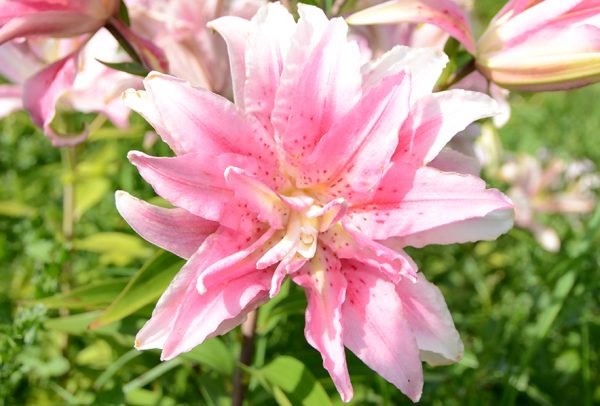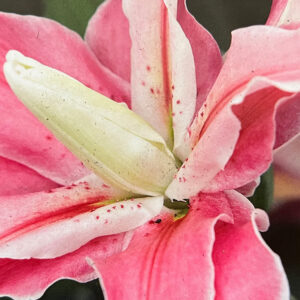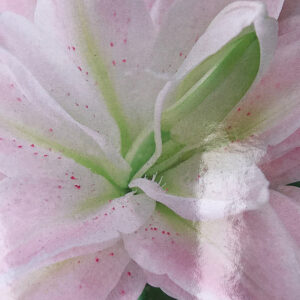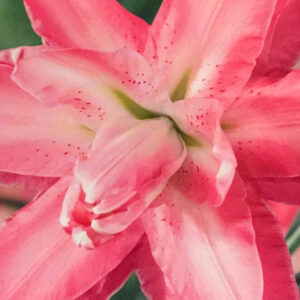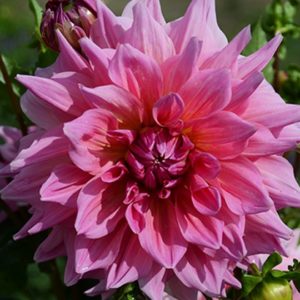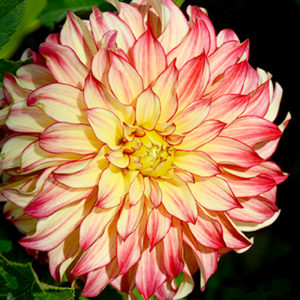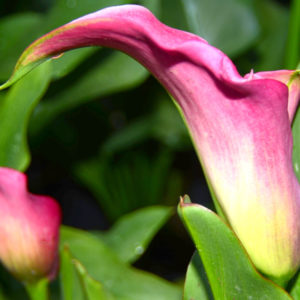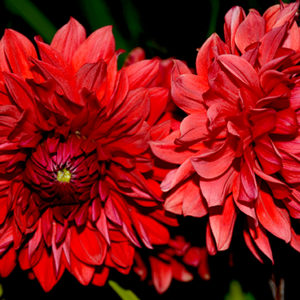Description
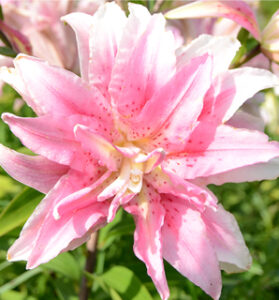 Oriental Lily, Isabella
Oriental Lily, Isabella
The lilium genus, surprisingly, is only indigenous to the temperate zones of the Northern Hemisphere, but it has been so popular for so many centuries that it is worldwide in distribution. There are many, many species native to North America, Asia and Europe. Flowers are of many different sizes and shapes – some highly fragrant, some not. Lilies were a part of the Greek and Roman civilizations. New World lilies and the lilies of China and Japan were quickly and eagerly embraced by Europeans and the British.
Since the Renaissance, the development and cultivation of lily cultivars has proliferated, but it was not until the late 1800s that the most significant lily introductions were created. E. H. Wilson (1876-1931), the Director of The Arnold Arboretum outside of Boston, MA introduced L. davidii, L. regale, and L. sargentiae. These three lily species became the most important lilies of the 20th century.
Asiatic and Oriental lilies are often very similar in appearance and many astute and experienced gardeners see no difference in the two. However, there are differences and these can be substantial. Asiatic lilies are slightly easier to grow and multiply much more rapidly. The flowers bloom much earlier than Orientals, are slightly smaller than Orientals and are usually a single color. Asiatics have the greatest range of blossom shape and color. Asiatic lilies are usually shorter plants and the blooms have little or no fragrance. Oriental lily plants grow taller than Asiatics, flowers can be heavily fragrant and are usually much larger than the Asiatic blossoms. Orientals bloom much later than Asiatics so it is best to plant both Asiatics and Orientals for continuous blooms from early summer to fall.
Planting Lilies in Your Garden
Two important facts that must be remembered when cultivating lilies is that they cannot stand wet feet. They need well drained soil, and if they do not have this, they will rot quickly. The second fact is lily bulbs are never dormant. There is always some activity going on in the bulb. It can be strengthening due to seasonal exposure to cold, food transference from roots to scales and scales to the growing point or top growth production. Because of this constant activity, lilies must be handled gently at all times.
To plant lilies in the ground, dig holes that are 8-10 inches deep and dust the holes with bone meal (1/4 cup per bulb). Place the bulb in the hole, pointed side up, and fill the hole with soil. Lilies prefer organically rich soil, so mixing peat moss, compost, and/or dehydrated cow manure into the soil produces stronger plants and more flowers. The Oriental Trumpets and the Oriental lilies should be planted12-14 inches apart. The Asiatics should be planted 12-14 inches apart.
Once the lilies have emerged from the soil, you can fertilize with a blossom booster fertilizer, but you do not have to do this. You will still get beautiful blooms if you do not fertilize at all. Lilies also like their heads in the sun and their feet in the shade. This can be accomplished by planting low growing annuals like alyssum, ageratum or non-vining nasturtiums where you are also growing the lilies or planting the lilies beneath shrubs or perennials.
Planting Lilies in Containers
Lilies LOVE being grown in containers, but the containers must be deep – at least 10-12 inches. Use the soil mix described in detail in our Harvesting History YouTube video. Do not use prepared soil mixes.
The Best Soil Mix for Containers
Briefly the soil mix is 60% topsoil, 20% peat moss and 20% compost or dehydrated cow manure. You can plant according to the following chart:
| Type | 10-12 inch | 14 inch | 18 inch |
| Asiatics | 3 Bulbs | 5 Bulbs | 10 Bulbs |
| Orientals | 2-3 Bulbs | 3-5 Bulbs | 6-8 Bulbs |
| Oriental Trigrinum | 1 Bulbs | 1 Bulbs | 2 Bulbs |
Plant the bulbs 8 inches deep. Dust the hole with ¼ cup bone meal per bulb. Cover the bulbs with 8 inches of soil. Water heavily, but do not allow the pots to stand in water. Once the lilies have emerged from the soil, fertilize every two weeks with blossom booster fertilizer.
In the fall, when the top growth has died completely back, remove the dead growth and dust the surface of the soil with bone meal. Mulch with 2 inches of compost, if possible, or a mix of peat moss and dehydrated cow manure-5 parts peat moss to 1 part manure.
Make sure you water your lilies throughout the summer. Do not allow the pots to dry out.

